Symbols and Myth at a glance
- Details
- Written by AndEl
Egyptian Symbols and Mythology at a Glance
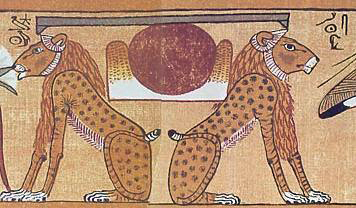
Aker (Akeru, Akerui)
The double lion god
Symbols: akhet
Depiction: Depictions showed Aker as a double-headed lion or two lions sitting back-to-back with the sun and sky appearing between them. The two lions form the Egyptian symbol for the sky, akhet. The lions were named Sef (Yesterday) and Duau (Today).
Mythology: The Egyptian believed that Aker, an earth-god, guarded the gates of dawn and sunset through which the sun rose every morning and set every evening. The ancient Egyptians placed statues of Aker at the doors of palaces and tombs to ward off evil spirits and malicious entities. Statues of Aker often were given the heads of men and women, which the ancient Greeks referred to as sphinxes.
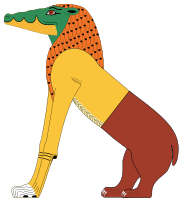
Ammut (Ammit, Ahemait)
The dead devourer
Depiction: A goddess, Ammut was depicted with the head of a crocodile, the forequarters of a lion, and the hindquarters of a hippopotamus.
Mythology: Ammut was a soul-eating monster. She witnessed the judgment of the dead in the "Hall of the Two Truths,” Maaty. Before souls could enter the afterlife they had to pass judgment by Osiris. As the king of the underworld, Osiris admitted only those souls who had lived good lives and who had received the proper burial rights under the protection of certain amulets and the recitation of certain words of power and divinity. To judge if a soul was worthy of entering the afterlife, the deceased’s heart was placed on one side of the Scales of Truth and a feather of Ma’at on the other side. If the heart, where the Egyptians believed the soul dwelled, was heavy with sins and out weighed Ma’at’s feather, Ammut ate the soul dooming it to eternal death. If the heart weighed equal to Ma’at’s feather the soul earned eternal life in the Duat, a fertile land.
Amon (Amen, Amun, Ammon, Amoun)
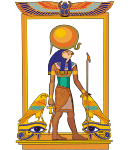
The hidden one
Symbols: bull, ram, goose
Depiction: Amon was depicted as a man seated on a throne holding an ankh in one hand and a scepter in the other. Amon was also depicted with the head of a cobra or frog. He could also appear as an ape or as a crouching lion.
Mythology: Amon was a creation-god. His name means, “what is hidden or cannot be seen.” During the Ptolemaic period, Amon was associated with the root word –men, meaning “to be permanent.” Though later traditions say that Amon was self-created, other traditions say Thoth created Amon as one of the eight gods of creation. According to myth, Amon’s wife was Mut and his son Khonsu (the moon). Amon’s historical role in Egypt is riddled with political intrigue. Originally a minor deity recognized in Thebes, Amon came into prominence in Upper Egypt with the accession of the prince of Thebes to power in Egypt. As a result of his rise in popularity, Amon was promoted to king of the gods some time after the 12th Dynasty when Thebes became the new capital of Egypt. Though worshipped by the wealthy, the common man considered Amon their god who protected the weak and upheld justice. To earn the god’s favor, people would confess their sins to Amon to demonstrate their piety. Amon’s favor among the Egyptian pharaohs waxed and waned as the queen Hatshepsut built the god a temple and claimed him as her father. Later, Thutmosis IV, shunned Amon for a purer sun god, Aten. The final blow to Amon’s popularity came when Thutmosis IV moved the Egyptian capital from Thebes and tried to erase any appearance of Amon from the public record. Akhenaten’s successor, Tutankhamon, restored Thebes as the capital of Egypt and restored the old gods. Never again did Amon regain the popularity he once enjoyed as future pharaohs worshipped the Osirian gods instead.

Anubis (Yinepu, Anpu)
The jackal
Symbols: jackal, ox-hide hanging from a pole, embalming equipment, flail, flags
Depiction: Anubis is portrayed as a black dog who accompanies Isis or as a man with a jackal’s head who holds a scepter. It is thought that Anubis was portrayed as a jackal because these scavengers were often seen lurking about graves and tombs. Ancient Egyptians began the practice of elaborately decorating graves and tombs to protect the dead from desecration by jackals.
Mythology: Anubis assisted in the funerary rites of the dead used to assure admittance of the dead into the underworld. Worshipped as the god of mummification, it was said that Anubis invented the process of embalming in order to preserve the body of Osiris who was briefly resurrected by Isis. Following a person’s death, it was believed that Anubis oversaw the embalming of the body, welcomed the body into the tomb, conducted the “Opening of the Mouth” ceremony, and escorted each soul to the “Field of Celestial Offerings.” During the test to determine whether a soul was worthy of entering the afterlife, Anubis monitored the Scales of Truth. This was done to preclude any deception by the gods that would condemn the soul to the unjust fate of eternal death in the belly of Ammut.
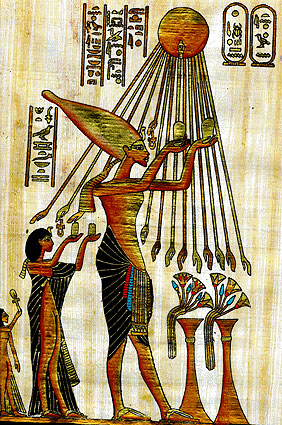
Aten
Lord of All
Symbols: sun disk, heat and sunlight
Depiction: Aten was depicted as a sun-disk with rays falling upon the Earth. At the end of each ray was a hand that extended the ankh to the pharaoh.
Mythology: The god of the sun, Aten was also called the creator of man. As the sun-god, Aten was born again each day. Like the sun, Aten nurtured the Earth and, according to the Book of the Dead, the deceased even called on him to nurture the living with his rays. The origin of Aten as the sun god is not clear. His rise to prominence came when the pharaoh Amenhotep IV, or Akhenaten, restored and enlarged a temple of Aten built by his father. The priest of Amon, who wielded substantial power at the time, did not like the promotion of Aten over Amon because it threatened their status. In response, Akhenaten built a new Egyptian capital, Akhenaten, “the Horizon of Aten.” Because the Egyptian pharaohs were gods, Akhenaten established a new religion, with himself and Aten as the major Egyptian deities. In this religion, access to Aten was only available through Akhenaten. Akhenaten took seriously the job of establishing a new state religion and attempted to erase all vestiges of Amon and all other gods. When Akhenaten died so did his new state religion.
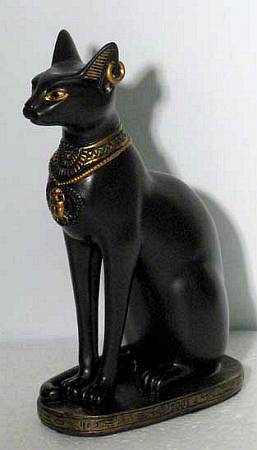
Bastet (Bast)
The Tearer
Symbols: cat, lioness, sistrum, Udjat (Eye of Horus)
Depiction: Until ca. 1,000 BCE, the goddess Bastet was depicted as a lioness. Later she was depicted as a woman with the head of a house cat. When portrayed as a lioness, Bastet was associated with sunlight. When portrayed as a cat she was associated with the moon.
Mythology: The daughter of Re and mother of Khonsu (the moon), Bastet was the goddess of cats, fire, the home, and pregnant women. Appearing in myth as both submissive and belligerent, Bastet protected expecting mothers and slaughtered enemies. Bastet was personification of the soul of Isis. The ancient Egyptians celebrated festivals in her honor in April and May at her cult center, Bubastis. According to the ancient Greek historian Herodotus, when the Egyptians traveled to Bubastis, they traveled in boats, men and women together. During the journey, some women shook rattles and some men played pipes while the remainder clapped their hands. The women on the boat taunted women on the banks of the river while the other revelers danced and made lots of noise. Upon arrival at Bubastis, a sacrifice was made and the revelers made merry by drinking lots of wine.
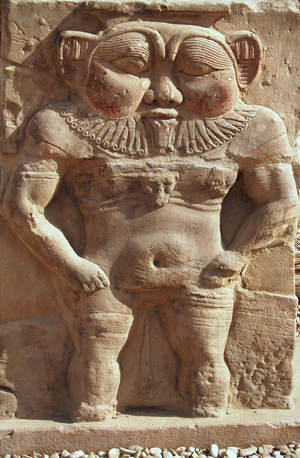
Bes
Symbols: Lion, knife, bells, drums
Depiction: Unlike most gods and people depicted in Egyptian art, Bes was often depicted in full-face frontal view. He was a dwarf who wore a crown of feathers on his head. He wore a beard and had a flat nose and bushy eyebrows and hair. His ears were large and the animal skin wrapped around his body had a tail that hung down in the back. When depicted as the god of music, Bes carried a harp. When depicted as the god of war, Bes wore a military style tunic and carried a sword and shield.
Mythology: A male deity and protector of children, Bes was the god of war and of music and dance. He was thought to be of African or Middle Eastern origins.
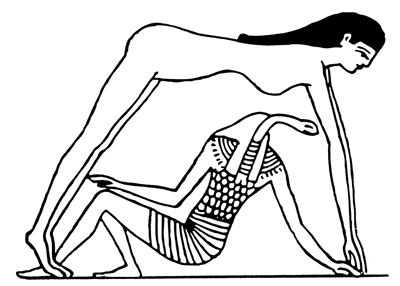
Geb (Seb, Gebb, Keb, Kebb)
Great Cackler
Symbols: goose, earth
Depiction: Geb is depicted as a man wearing the crown of the North or the South. His skin is either dark representing the rich soil of the Nile or green representing the color of Nile vegetation. Images of Geb portray him in a reclined position leaning on one elbow with one knee lifted. He lies beneath the air (Shu, his father) and the sky (Nut, his wife and sister).
Mythology: The god of the earth, Geb’s laugh was said to be the cause of earthquakes. His sister and wife was Nut, the goddess of the sky. He was the son of Shu and Tefnut. With Nut he produced four children, Osiris, Isis, Seth, and Nephthys. Geb’s duties as the god of the earth included guiding the dead to the underworld.
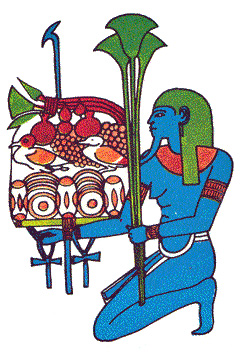
Hapi (Hapy)
Father of the gods
Symbols: running water
Depiction: Though a male deity, Hapi is depicted as a man with breasts and a round belly, which indicated nourishment and fertility. Since Hapi represented both the upper and lower Nile, he was depicted wearing papyrus plants when he represented Lower Egypt and lotus plants when he represented Upper Egypt. Depictions of Hapi, combining his oversight of both Upper and Lower Egypt, showed him holding both the papyrus and lotus plants in his hands.
Mythology: A male deity, Hapi is the oldest of the Egyptian gods whose name is an evolution of the ancient Egyptian word for Nile, hep. Hapi’s domain was divided into two parts, Upper (northern) Egypt and Lower (southern) Egypt. Hapi of Upper Egypt was called Hap-Reset. Hapi of Lower Egypt was called Hap-Meht. Since Hapi had two domains he also had two wives. In the north, there was Buto who was depicted as a cobra. In the south, there was Nekhebet who was depicted as a vulture. Among the pantheon of Egyptian gods, Hapi was one of the greatest. Egyptian mythology says that Hapi was the creator of all things, including the universe. Hapi was believed to have risen out of the earth between the two mountains, Qer-Hapi and Mu-Hapi between the islands of Elephantine and Philae. Associated with the gods of water Osiris and Nun, Hapi represented the annual flooding of the Nile, sometimes referred to as the “arrival of Hapi.” The Egyptians believed that the gods Khnemu, Anqet, and Satet guarded the Nile’s source and measured the amount of silt released annually by the river’s flooding. But it was Hapi who controlled the flooding so the ancient Egyptians threw offerings into the Nile in hopes of appeasing him so that he would provide the right amount of water to nourish their crops.
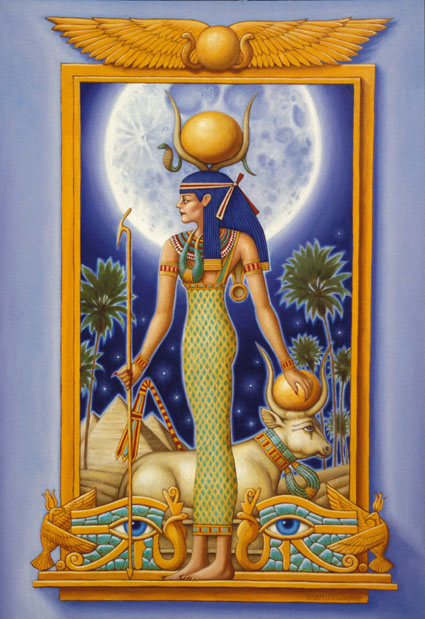
Hathor (Hethert, Athyr)
Mistress of heaven
Symbols: cow, lioness, falcon, cobra, hippopotamus, sistrum (a rattle), musical instruments, drums, pregnant women, mirrors, cosmetics, papyrus reed, snake
Depiction: Hathor was depicted as a woman with the head of a cow, as a cow, or as a woman wearing cow horns and holding a solar disk. The Hathors, who served a similar role as the Fates in ancient Greek mythology, were depicted as seven young women who wore the headdress of Hathor, horns and the solar disk. The women played tambourines.
Mythology: In some myths, Hathor is the mother of Horus and thus each queen of Egypt was identified with her. The name Hathor means “house of Horus.” Because Hathor was the Egyptians’ goddess of love, the Greeks identified her with their goddess of love, Aphrodite. Her father, Re, created Hathor for the purpose of destroying men who disobeyed him and originally named her Sekhmet. Re had a change of heart and no longer wanted to destroy men, but could not stop his daughter from killing them. Instead of destroying Sekhmet, Re tricked her by disguising beer as blood which Sekhmet drunk. Sekhmet became so intoxicated that she could no longer kill men and was from then on known as Hathor. In Dendera, her cult center, Hathor was considered the goddess of fertility and childbirth and in Thebes she was considered the goddess of the dead.
The Hathors played an important role in the fate of all Egyptians. According to myth, seven Hathors were present at every birth and foretold each baby’s fate, its future, and it’s death at the moment it was born. The hour of a person’s birth foretold their future and to be born at some hours was bad luck. If a prince were born at a bad hour, it was believed that the Hathors would exchange the baby with a lucky one to insure the continued prosperity of the country.
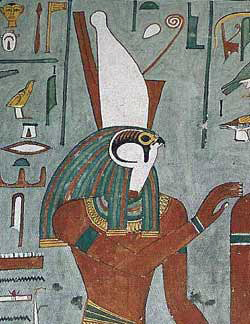
Horus (Hor, Heru, Her)
He who is above
Symbols: hawk, falcon, bull, Double Crown, Winged Disk, Sphinx, weapons, iron, blacksmiths
Depiction: Horus was often depicted as a child suckling at his mother’s breast. As a child, Horus was shown seated wearing a side lock and a royal crown and sucking his thumb. Perhaps because his father was dead when he was conceived or because he was born prematurely, in his child form Horus was depicted with a stunted lower body. As a result of Horus’ association with the sun, he was often depicted as the personification of the rising sun and a symbol of eternal life and resurrection. As the older Horus, Haroeris, he was depicted as a falcon-headed man wearing the crowns of Upper and Lower Egypt.
Mythology: The ancient Egyptians believed that their pharaohs were the earthbound embodiment of Horus, one of the greatest Egyptian gods. Egyptian pharaohs would take the name of Horus as their own to show their direct relation to him. The patronage of Horus was disputed and eventually justified by the Egyptians through the establishment of fifteen distinct forms of Horus. The fifteen forms of Horus fall into two categories, the solar god and the son of Osiris. Horus, when associated with the sun, was said to be the son of Atum, Re, or Geb and Nut. As the son of Isis and Osiris, Horus is called Harsiesis, which means “Horus the son of Isis”. Isis was said to have conceived Horus miraculously by resurrecting Osiris just long enough to conceive Horus. Isis alone raised Horus, who as a child was known as Harpokrates, “the infant Horus.” She raised him on a floating island called Chemmis to protect the child from his uncle Seth. Seth wanted to murder Horus, but Isis protected the child so that some day he might avenge his father’s death.
Horus was also known as an older god and was called Haroeris, “Horus the Elder.” This Horus was said to be the son or husband of Hathor and the brother of Osiris and Seth. Horus had four sons born of the lotus flower, Qebehsenuef, Duamutef, Imsety, and Hapi. His four sons were solar gods and it was believed that Anubis made them responsible for mummification, the “Opening of the Mouth,” and the burial of Osiris and all men. Each son protected an internal organ of the deceased. For example Imsety protected the liver, Hapi the lungs, and Duamutef the stomach. A goddess protected each son. These were not Horus’ only children as he was said to have had many children and many wives.

Isis (Aset, Ast)
Symbols: throne, kite, scorpion, sistrum, tiet (the "Knot of Isis")
Depiction: Depictions of the goddess Isis showed her as a woman wearing the solar disk between a pair of horns and a vulture headdress. Sometimes she is shown wearing the crowns of Upper and Lower Egypt sporting a pair of ram’s horns or the feather of Ma’at. Isis was also depicted as a woman, not a goddess, with a simple ordinary headdress and with a uraeus on her forehead.
Mythology: Isis was the daughter of Nut and Geb and the sister and wife of Osiris. In myth, Isis aided her husband during his reign as the king of Egypt and searched madly for his body after his death so that he might be given a proper burial. Isis conceived her son Horus either through magic or by resurrecting Osiris. Isis raised Horus on a floating island called Chemmis to protect the child from his uncle Seth. Seth wanted to murder Horus, but Isis hid the child so that some day he might avenge his father’s death.
The ancient Egyptians saw Isis as a benevolent goddess, good and kind. Each pharaoh was her son and Isis loved all creatures like a mother. She was the chaste and devoted wife and as a result most highly regarded among the Egyptian gods. Her benevolence resulted in her worship beyond Egypt and as far away as Great Britain. The ancient Greeks associated Isis with Athena and Tethys. In the Egyptian Book of the Dead, Isis is the giver of food and life to the dead. In the Pyramid Text, Isis suckles each pharaoh at her breast as his mother. The pharaoh was considered the embodiment of Isis’ son, Horus, on earth. Isis was also known for her magic and, with this gift, created the first cobra.
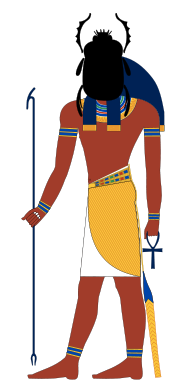
Khepri (Khepra, Khepri, Khopri)
He who comes into existence
Symbols: scarab beetle
Depiction: Khepri’s association with the dung beetle and his role as a sun god resulted in his depiction as a man with a beetle on his head or with a beetle head rolling the sun and moon across the sky.
Mythology: The god of the rising sun, Khepri was on manifestation of Re. He would roll the sun across the sky like a dung beetle roles its ball of dung in which it lays its eggs. The Egyptians believed that Khepri created himself just as it appeared dung beetles (scarabaeus sacer) did when their larvae emerged from the dung ball. Khepri was associated with self-renewal and self-generation.
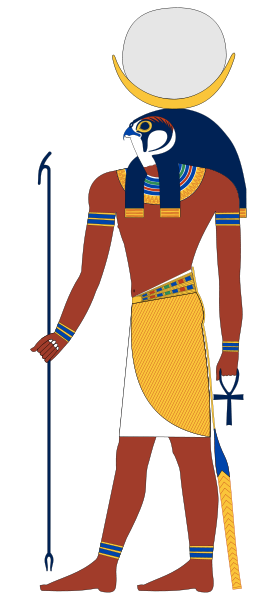
Khonsu (Khensu, Khons)
Symbols: crescent moon, hawks, knife
Depiction: Khonsu is depicted as a man with the head of a hawk who wears the lunar disk. In some depictions, he is a child who wears the mark of youth, the side lock.
Mythology: Khonsu’s name comes from the ancient Egyptian word khens, which means to travel, to run, or to move about. An ancient deity, Khonsu is the son of Amon-Re and Mut. Khonsu is a moon-god, who was said to cause the crescent moon to shine, cattle to become fertile, women to conceive, and for the lungs of the people to fill with fresh air.
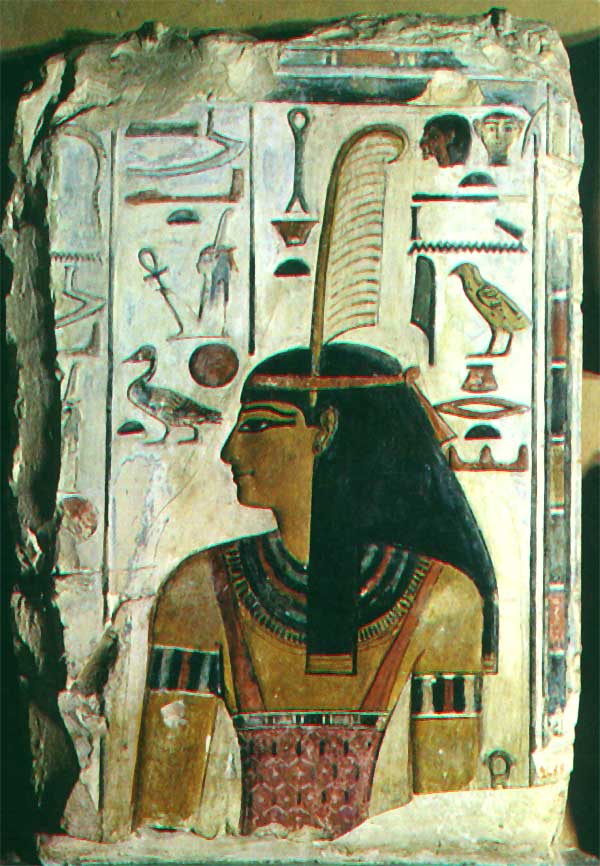
Ma’at (Mayet)
The goddess of truth
Symbols: ostrich feather, scales
Depiction: Depicted as a seated or standing woman, Ma’at held an ankh in one hand and a specter in the other. She wore an ostrich feather in her hair. Some depictions showed Ma’at as a woman with an ostrich feather for a head or with wings attached to her arms.
Mythology: A positive force in the life of the ancient Egyptians, Ma’at was the goddess of truth, order, and Egypt’s physical and moral law. Ma’at had eight children with Thoth; one of these children was the god Amon. Together with Ammut, Ma’at judged the souls of the dead in the "Hall of the Two Truths,” Maaty. Before a soul could enter the afterlife it had to pass judgment. To judge whether a soul was worthy of entering the afterlife, the deceased’s heart was placed on one side of the Scales of Truth and the feather of Ma’at on the other side. If the heart, where the Egyptians believed the soul dwelled, was heavy with sins and outweighed Ma’at’s feather, Ammut ate the soul, dooming it to eternal death. If the heart weighed equal to Ma’at’s feather the soul earned eternal life in the Duat. The ancient Egyptian word ma’at means truth.
Ma’at served as a guide to Re, the sun god, as he made his journey across the sky in his boat. Ma’at guided the Egyptian pharaoh’s in their journey through life having been set in place as principles to live by when the world was formed. If a pharaoh failed to uphold the truth, ma’at, then the chaos that existed before Ma’at would return and the world would be destroyed.

Min
Chief of Heaven
Symbols: phallus, lettuce, bull
Depiction: Min was depicted as a bearded ithyphallic man carrying a lightening bolt in one raised arm. Min’s legs were close together and he wore the headdress of Amon.
Mythology: In pre-dynastic times, Min was the god of the sky and chief of heaven. From the time of the Middle Kingdom to the New Kingdom, Min was called Shu or Re and was identified with Horus the Elder. During the time of the New Kingdom, Min was associated with Amon-Re. Also, at this time, his popularity rose and orgiastic festivals were held in his honor. This stands to reason because Min was the god of fertility. Egyptian men believed that Min bestowed sexual powers on them. Min was the rain god who nourished the fields with his seed. Min’s sacred plant was long lettuce because the Egyptians believed it had aphrodisiac properties and because it produced a milky semen-like sap.
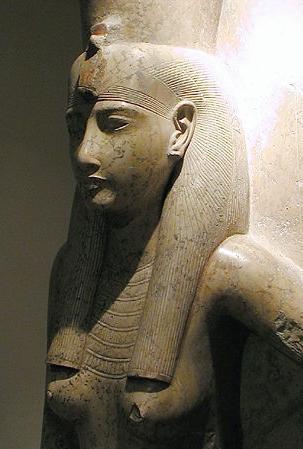
Mut
Lady of Heaven
Symbols: Double Crown, vulture, cobra, lioness, queen
Depiction: Depictions of Mut showed her holding the papyrus scepter and the ankh, the symbol of life. On her head she wore the Double Crown of Upper and Lower Egypt. Other depictions of Mut showed her as a woman with the heads of a man, a woman, and a vulture, with a phallus, the claws of a lion, and wings. Mut was also depicted as a woman standing with her arms stretched out straight with a large pair of wings. The feather of Ma’at appeared at her feet.
Mythology: One of the divine triad that dominated Egypt during the New Kingdom, Mut was a mother goddess regarded as the mother of pharaohs. Her husband was Amon and her son Khonsu, the moon god. Her name means “mother” or “one who dives birth” although, according to myth, she was self-created.
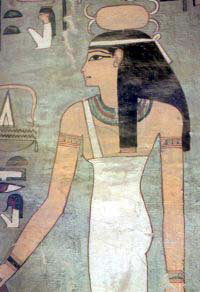
Neith (Nit, Neit, Net)
Great Goddess
Symbols: bows and arrows, shields and weapons, Red Crown, weaving shuttle
Depiction: Depictions of Neith from Upper Egypt showed her as a woman with the head of a lioness. Other depictions showed her as a woman holding a specter or two arrows and a bow wearing the Double Crown of Upper and Lower Egypt. At times, depictions of Neith showed her crowned with a weaving shuttle. She was often shown suckling her son Sobek in the form of a crocodile.
Mythology: The goddess of war and weaving, Neith was one of the oldest Egyptian gods. Neith was considered both male and female in nature and was self-created. Originally worshipped and honored throughout Egypt as the goddess of war, her role evolved over time to the goddess of weaving. Neith was said to be the mother of Sobek and Re. According to myth, it was Neith who offered the solution to the dispute between Seth and Horus over who should succeed Osiris as the king of Egypt. Neith suggested that Horus take the throne and, as consolation, Seth take two Semitic goddesses. Neith’s wisdom prevailed with all of the gods agreeing to the arrangement, except Seth. The largest temple to Neith, called Sapi-meht, was located in the capital of the fifth nome of Lower Egypt, Sais. At Sais, the ram-headed creation god Khnemu was her husband and her son was Tutu, a form of the god Shu.
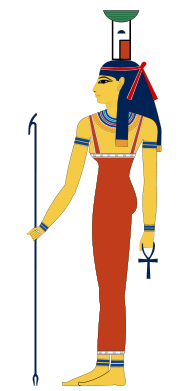
Nephthys (Nebt-het, Nebhet)
Lady of the house
Symbols: kite, crow, bones and skulls
Depiction: Depictions showed Nephthys as a woman wearing the symbol of her name on her head or her symbol on top of a pair of horns. Her name, Nebt-het, means “lady of the house,” house being the sky where Horus lived.
Mythology: According to myth, Nephthys was the daughter of Geb and Nut, the sister of Osiris and Isis, and the sister and wife of Seth. Throughout Egyptian mythology, Nephthys was always the counterpart to Seth. Nonetheless, Nephthys had a son, Anubis, by Osiris who was seduced by Nephthys after she got him drunk. Another myth says that Nephthys disguised herself as Osiris wife, Isis, and seduced him to conceive Anubis. Nephthys’ seduction of Osiris only fed Seth’s hatred of Osiris and fueled Seth’s desire to kill him. In myth, Nephthys was portrayed as a loyal friend to her sister, Isis, who helped her search for Osiris’ body after his death and who rebuilt Osiris’ body once it was found.
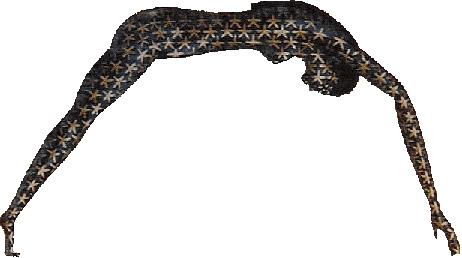
Nut (Nuit)
The Sky
Symbols: stars, the night sky, cows
Depiction: Depictions showed Nut as a woman wearing a vase of water on her head with her hands and feet touching the ground to form an arch. This arch or semi-circle represents the sky and heaven. Her father the god of air (Shu) holds Nut, the sky, above her husband, Geb, the earth. According to myth if Shu ever left his duty chaos would return.
Mythology: Nut was the goddess of the daytime sky and later the goddess of the entire sky and was the place where clouds formed. Her father and mother were Shu and Tefnut. Her husband was the earth god Geb, with whom she had four children, Osiris, Isis, Seth, and Nephthys. Nut’s children were born on the five (5) epagomenal days of the Egyptian year as described in The Story of Re. Egyptians held celebrations each year on these five days. The day of Osiris was unlucky, as were the days of Nephthys and Seth. The day of Horus the Elder was both lucky and unlucky. The day of Isis was lucky. Given her position as the sky, Nut gave birth to the sun every day. Through the day he passes under Nut’s arched body, through her mouth and body and was reborn again the next day. Alternatively, the sun takes the boat Atet up Nut’s legs, changes boats at noon, and takes the boat Sektet over Nut’s body until sunset.
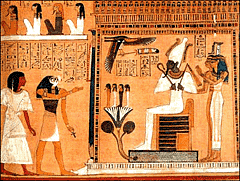
Osiris (Asar, Wesir, Ausar, Unnefer)
King of the dead
Symbols: crook and flail, Bennu (phoenix), djed, White and atef Crowns, bull, mummified form
Depiction: Depictions of Osiris showed the god as green faced and bearded holding the flail and crook in his hands. He was portrayed as a mummified human who wore the atef crown.
Mythology: Osiris held an important role in ancient Egypt. His death at the hand of his brother Seth represented the yearly Egyptian drought, while his miraculous rebirth represented the flooding of the Nile Valley and its nourishment by the silt left on the land after the flood. Osiris’ parents were Nut and Geb. His sister and wife was Isis. He also had another sister, Nephthys, and a brother, Seth. Osiris was the father of Horus by Isis and of Anubis by Nephthys, who seduced Osiris to conceive Anubis. Osiris’ rivalry with his brother Seth, the god of storms and the desert, represented the constant struggle in Egypt between the fertile Nile Valley and the surrounding desert. Osiris’ death and rebirth also represented the rising and setting of the sun.
Osiris was an earth god and the god of vegetation. According to myth, it was Osiris who brought civilization to Egypt whose population was once cannibalistic and barbarous. Having inherited the throne from his father Geb and being distressed by the behavior of the Egyptian people, Osiris taught the Egyptians how to farm, what to eat, and gave them laws and religion. With the assistance of Thoth, who invented science, nomenclature, and the arts, Osiris ruled as the benevolent and kind king of Egypt. Once he had established civilization in Egypt, Osiris traveled to distant lands to teach others what he had taught the Egyptians. He left Isis to rule in his absence but Seth’s actions troubled her. While Osiris was away, Seth plotted to usurp the throne and take Isis as his wife. Isis’ fears were realized when, in the twenty-eighth year of Osiris’ reign, on the 17th day of Hathor (late September or November), Seth and 72 conspirators murdered Osiris. Seth and his co-conspirators threw the coffin containing Osiris’ body into the Nile. Isis recovered Osiris’ body only to have Seth tear it into 14 pieces, which he scattered all over Egypt. Nonetheless, Isis with help from Nephthys, recovered every piece of Osiris’ body excluding his penis, which was eaten by the Nile fish. Using her magical powers, Isis reassembled Osiris and gave him life just long enough to conceive Horus, the future king of Egypt. Seth disputed Horus’ succession to the Egyptian throne and the matter was not resolved for 80 years when Nephthys offered a resolution to the dispute.
Ancient Egyptian religious texts describe Osiris as the god of the dead with the understanding that Osiris died and was resurrected. As the king of the underworld, Osiris admitted only those souls who had lived good lives and who had received the proper burial rights under the protection of certain amulets and the recitation of certain words of power and divinity. If Osiris judged a soul worthy, it was allowed to live out the afterlife in the Duat, a fertile land. According to myth, Osiris’ domain lay beneath Nun in the northern part of heaven or to the west. “Osiris” is the Greek corruption of the Egyptian name “Asar.” Asar has several meanings including “he sees the throne” and the strength of the eye.” There are at least 158 hieroglyphs representing Osiris. The simplest one is a throne positioned over an eye.
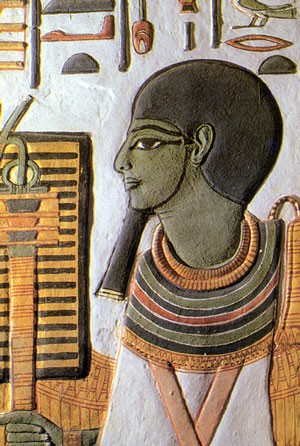
Ptah
The Opener
Symbols: level, plumb-line, bricks, Djed
Depiction: Depictions of Ptah showed him as a man shrouded like a mummy with a beard and a skullcap on his head. In one hand he holds the Djed, the sign of stability, and in the other the ankh, the symbol for “life.”
Mythology: By thinking them with his mind and saying them with his tongue, Ptah brought all things into being. Unlike other creation gods, Ptah created with his mind not with his actions. Ptah’s cult center was the ancient city of Memphis where his priest pronounced that Ptah’s heart and tongue gave birth to gods, kept order, and founded cities. Ptah was the god of architects and skilled craftsmen. In the artisan community of Deir-el-Medina, near Western Thebes, the craftsmen carved ears on the statues of Ptah so that he would listen to their prayers. Path’s wife was the lioness-goddess Sekhmet and his son was said to be either Imhotep or Nefertem.
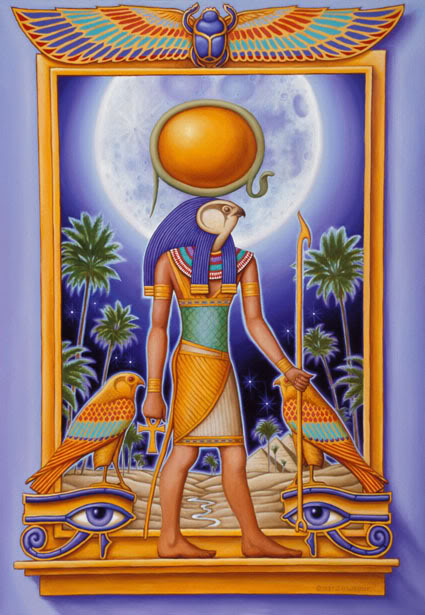
Re (Ra)
Father of the gods
Symbols: sun, falcon, obelisk, pyramid, Udjat (Eye of Horus), Bennu (phoenix)
Depiction: Depictions of Re showed him as a hawk or falcon or hawk-headed man. Some depictions showed Re as the combination of Ra-Hoor-Khuit (Re who is Horus of the Horizons) and Horus, the falcon god.
Mythology: Re was the god of the sun and was associated with Horus, the god of the sky. Re was known as the creator of men by some and became the state deity during the Fifth Dynasty. An ancient god, Re was the father of Shu and Tefnut, the grandfather of Geb and Nut, the great-grandfather of Seth, Nephthys, Isis, and Osiris. According to myth, Re traveled through the waters of heaven in two different boats each day. The first boat, Madjet (“becoming strong”), was a galley that rose out of the east behind the Mount Manu and then passed between two sycamore trees. The second boat, a small barge called Semektet ("becoming weak"), took Re to sunset. Ma’at determined the course of this boat. Re did not navigate the boats himself, Horus, accompanied by Ma’at, navigated the boat for Re. In front of the boat swam Abtu and Ant, two pilot fish. Geb, Hu, Sia, and Hike traveled with Re. And at night, the god Upuaut stood on the boat’s prow. Re’s travels were impeded by three monsters, Sebau, Nak, and Apep. In order for the sun to rise, Re fought and defeated these monsters every night. Apep, the personification of darkness, was the most powerful of the three monsters and was depicted either as a serpent or crocodile. If Apep defeated Re, then the weather was stormy. If Apep swallowed Re’s ship then a solar eclipse occurred. The Book of Overthrowing Apep provided incantations and information on how to defeat Apep.
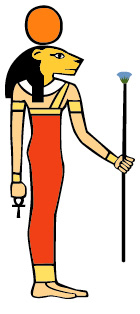
Sekhmet (Sekhet, Sakhmet, Nesert)
Mighty One
Symbols: lioness, cobra, Udjat (Eye of Horus)
Depiction: The lioness goddess of war and destruction, Sekhmet was depicted as a woman in red with the head of a lioness with the solar disk and the uraeus on her head.
Mythology: The name Sekhmet comes from the Egyptian word sekhem meaning “to be violent, mighty, and strong.” Together Sekhmet and Bastet were the Goddesses of East (Bastet) and West (Sekhmet). The wife and sister of Ptah, Sekhmet was born out of the fire of Re’s eye. Re created Sekhmet as a weapon of vengeance with which to destroy disobedient and wicked men. The ancient Egyptians feared the powers of Sekhmet and developed complicated rituals to appease the goddess. Every day of every year in the morning and afternoon, ancient Egyptian priests would perform these rituals in front of each of 700 statues of Sekhmet. The Egyptians believed that if the priests did not adhere to this strict regiment of rituals, Sekhmet would destroy them. Re had a change of heart and no longer wanted to destroy men, but could not stop his daughter from killing them. Instead of destroying Sekhmet, Re tricked her by disguising beer as blood which Sekhmet drunk. Sekhmet became so intoxicated that she could no longer kill men and was from then on known as Hathor.

Seth (Set, Suetekh)
Lord of Upper Egypt
Symbols: donkeys, fish, pigs, Seth-animal
Depiction: Depictions of Seth showed him as a mythical animal resembling a donkey or aardvark. He has big ears and red hair.
Mythology: Seth was the god of thunder and storms as well as the desert. His parents were Nut and Geb, his brother was Osiris, and his sisters were Isis and Nephthys. Though married to Nephthys, Seth never had any children, a fact that contributes to his association with the barren desert and infertility.
Upon his abdication of the throne, the older of his two sons, Osiris, succeeded Geb as king of Egypt. Once Osiris had established civilization in Egypt, he traveled to distant lands to teach others what he had taught the Egyptians. He left Isis to rule in his absence but Seth’s actions troubled her. While Osiris was away, Seth plotted to usurp the throne and take Isis as his wife. Isis’ fears were realized when, in the twenty-eighth year of Osiris’ reign, on the 17th day of Hathor (late September or November), Seth and 72 conspirators murdered Osiris. Seth and his co-conspirators threw the coffin containing Osiris’ body into the Nile. Isis recovered Osiris’ body only to have Seth tear it into 14 pieces, which he scattered all over Egypt. Nonetheless, Isis, with help from Nephthys, recovered every piece of Osiris’ body except his penis, which was eaten by the Nile fish. Using her magical powers, Isis reassembled Osiris and gave him life just long enough to conceive Horus, the future king of Egypt. Seth disputed Horus’ succession to the Egyptian throne and attempted to murder Horus but failed because Isis protected Horus by keeping him on a floating island. Collectively, the gods decided to punish Seth for committing fratricide by sending him into exile in the desert. Re did not support the decision of the gods and thought Horus too young to hold the kingship. To resolve the stalemate, Isis magically transformed herself into a beautiful woman and with tears streaming down her face told a story to the gods. The story told of an evil man who killed her husband and who was trying to steal her family flocks. Angered by the injustice of which Isis spoke, Seth proclaimed that the evil man should be destroyed and that the woman’s son should inherit the family flocks. With this judgment, Seth lost the throne of Egypt. After an 80 year dispute, the gods agreed that Horus, Osiris’ son, should have the throne and that Seth should be given the Semitic goddesses Astarte and Asat.
Never considered wholly evil, Seth protected the barge of Re when Re fought each night with Apep. Before it was conquered by Upper Egypt, Lower Egypt considered Seth their benefactor. When the two lands united, Seth and Horus were depicted together as the state deities. During the 19th Dynasty, pharaohs even took Seth’s name often in the form of Seti.
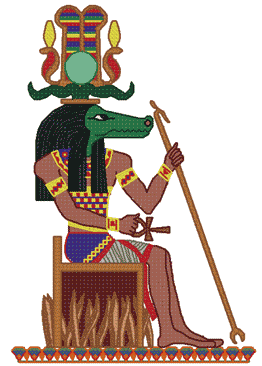
Sobek (Sebek)
He who causes to be fertile
Symbols: Crocodiles
Depiction: The male deity Sobek was depicted as a crocodile or as a man with the head of a crocodile.
Mythology: As told in the Book of the Dead, Horus the Elder enlisted the help of Sobek to kill his uncle Seth. Sobek helped Horus on another occasion when he rescued Horus’ four sons from the waters of Nun. Sobek was the god of crocodiles. Ancient Egyptians, who lived in cities that depended on water, worshipped him to placate the crocodiles. For instance, the people of Crocodilopolis (Arsinoe) would husband crocodiles in pools and adorn them with jewels. The importance of crocodiles to ancient Egyptian culture is demonstrated by the numerous mummified crocs that have been found in tombs.
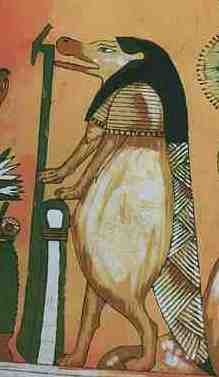
Taurt (Taweret, Taurtet, Taueret, Thoeris)
The great lady
Depiction: This pre-dynastic goddess was depicted as a pregnant female hippopotamus with large breasts, the tail of a crocodile, and the hind legs of a lioness. Depictions of Taurt showed her standing on her hind legs holding the ankh and leaning on the symbol of protection. Taurt wore the solar disk and the horns of a cow on her head.
Mythology: As a domestic deity, Taurt’s primary role was to protect pregnant women. She assisted the gods Bes and Hatshepsut at childbirths. This role was appropriate for a mother goddess who was said to help in the daily birth of the sun. According to myth, she was called the “Eye of Re” and the mother of Osiris and Isis. But Taurt was not always considered a benevolent goddess since she allegedly was the concubine of Seth. Taurt redeemed herself by siding with Horus during the dispute between Horus and Seth over who was to succeed Osiris as the king of Egypt.
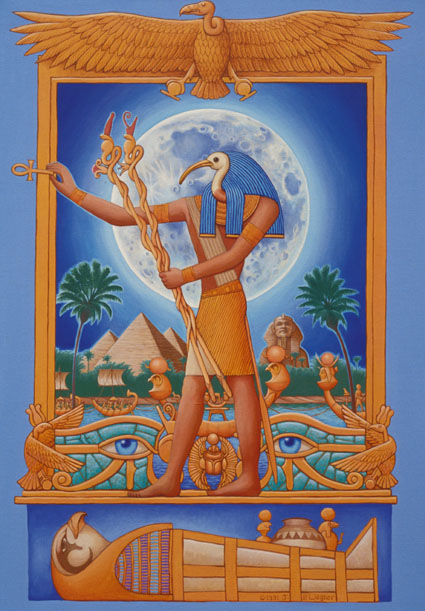
Thoth (Djehuty, Tahuti, Tehuti)
The great measurer
Symbols: baboon, ibis, writing palette and reed pens
Depiction: Thoth is the wise god who was often depicted holding scrolls and a pen with which he recorded all things. He was depicted as a man with the head of an ibis or baboon, though some times he was the dog-headed ape. He was most often depicted as a dog-headed ape when attending the judgment of a soul.
Mythology: Thoth was the god of writing, wisdom, learning, and the moon. According to myth, Thoth invented writing, was the author of the Book of the Dead, and was the vizier and scribe of the afterlife. With his wife Ma’at, Thoth had eight children, including the god Amon. Thoth was a self-created god who invented magic and the hermetic arts. Associated with the moon, Thoth rose after sunset to vanquish darkness. Thoth was present at the judgment of souls and sat on top of the scale that weighed the hearts of the dead against the feather of Ma’at. When passing judgment on the deceased, the baboon Thoth told the ibis-headed Thoth when the scales were balanced. The ibis-headed Thoth related his findings to the other gods who were present at the judgment.
Source Here
Liked this article? Dive deeper into personal growth and wellness! Check out CrystalWind.ca for spiritual wisdom or explore AromaWorx.ca for natural well-being tips. Spread the positivity—share this with friends on their happiness journey!
Let’s Chat! Drop Your Thoughts Below! ![]()
Latest Articles
Dive into the Mystical World of the Crystal Wind Oracle Deck!
Get All the Enchanting Details Now!
NEW Expanded Boxed Edition!
Now with 58 Cards for Richer Wisdom!

Imagine a world of inspiration and healing, free for all—made possible by YOU!
Donate Now—Ignite the Magic at CrystalWind.ca!

Epilepsy - Finding A Cure
Your donation can make a difference!
Help us find a cure – donate now!
Unlock Your Light: Join Lightworkers Worldwide on CrystalWind.ca!
Articles: Hindu Mythology
Articles: Egyptian Mythology
Articles: Compendium
Follow Us!
Featured This Month
Abalone Shell
Echos Of The Ancestors Abalone strengthens the structure of the body and th... Read more
Sun in Cancer
Cancer Sun Sign Characteristics Overview The name "Cancer" comes from Latin, ... Read more
Cancer Mythology
The Mythology of Cancer: A Celestial Tale of Loyalty and Sacrifice Among th... Read more
Chalcedony
The Stone Of Orators Chalcedony was very popular as a decorative stone in ant... Read more
Lammas by The Hedgewitch
Although in the heat of a Mid-western summer it might be difficult to discer... Read more
Lugh - Celtic God Of The Sun
The god Lugh was worshiped in Ireland as a deity of the sun. This connection... Read more
Egyptian Zodiac/Astrology
Egyptian astrology was one of the earliest forms of astrology. The Egyptians w... Read more













































